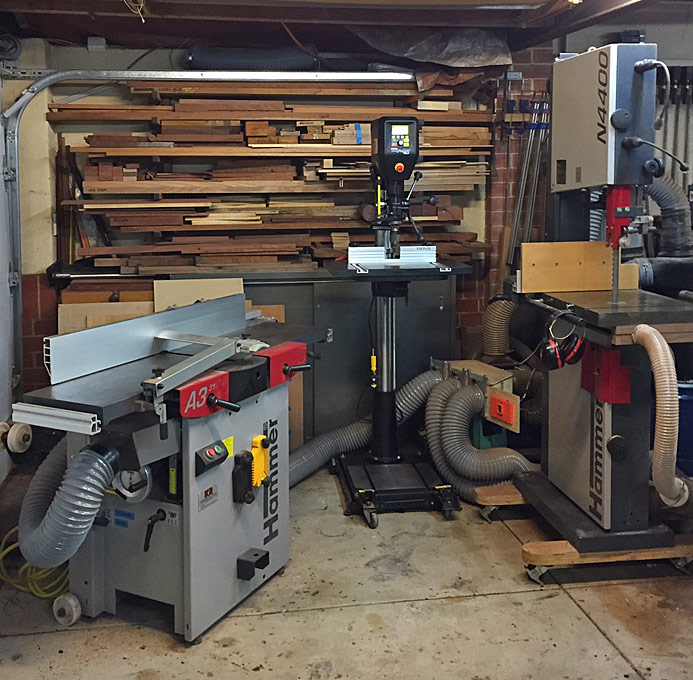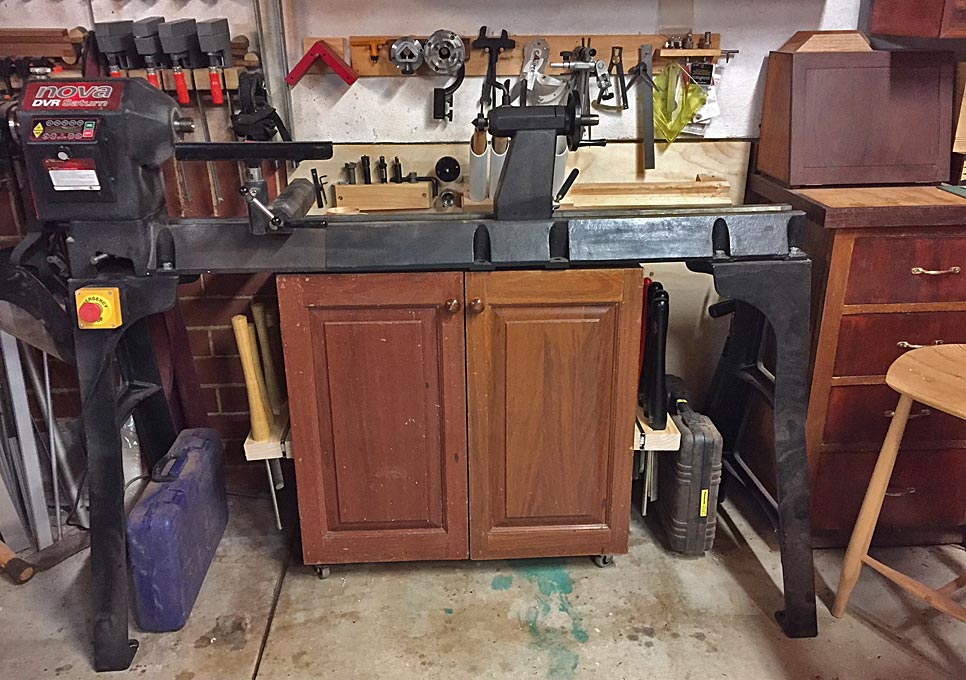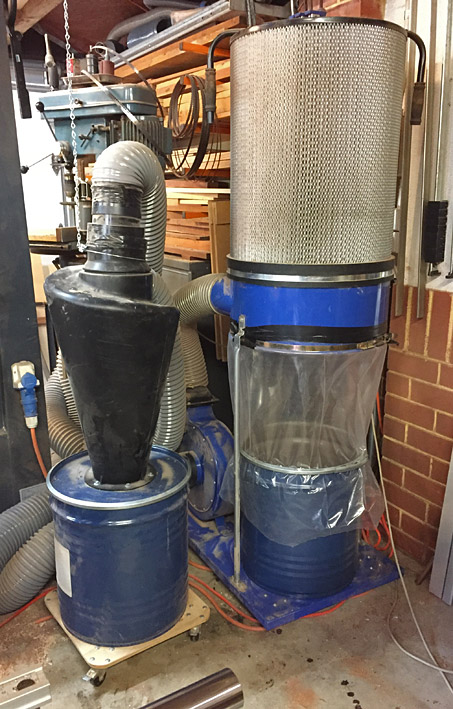 Needs Pictures: 0
Needs Pictures: 0
 Picture(s) thanks: 0
Picture(s) thanks: 0
Results 16 to 25 of 25
-
15th September 2022, 08:57 AM #16
 .
.











- Join Date
- Feb 2006
- Location
- Perth
- Posts
- 27,785

If it's primarily in terms of safety, then Bandsaws are involved in ~3.5x more incidents per hour of use than table saws.
The reason that we hear of many more TS than BS incidents is probably because there are many more TS's out there than BSs.
The other reason I think comes into play is that BS look safer so users are more relaxed and over confident about using them
Nearly half of all TS incidents involve kick back which have a chance of being more serious than mere removal of a digit but use of riving knives and correct use of fences etc can significant reduce those incidents.
On the whole I do use my BS, and SCMS more than my TS which mainly gets used for cutting Al these days so a negative raked toothed blade sits more or less permanently on the TS. If its not sheet material, by the time I've changed the blade Ive already done the cuts on one of the other saws.
-
15th September 2022 08:57 AM # ADSGoogle Adsense Advertisement
- Join Date
- Always
- Location
- Advertising world
- Posts
- Many
-
15th September 2022, 09:35 AM #17
 SENIOR MEMBER
SENIOR MEMBER











- Join Date
- May 2013
- Location
- Auckland, New Zealand
- Posts
- 997
-
15th September 2022, 10:53 AM #18
 SENIOR MEMBER
SENIOR MEMBER











- Join Date
- Oct 2019
- Location
- Brisbane, Australia
- Age
- 43
- Posts
- 519

Bob do you think that would hold for re-sawing operations? As opposed to what one would really expect would be the day-in, day-out intensive for tablesaws which would assume shops presumably cutting sheet goods all day for cabinetmakers (let's face it, very few kitchens or shop fit-outs would be using solid woods these days).
I suspect a factor - just a factor - is what bandsaws are typically used for, which often includes riskier operations like trying to saw big logs without a good jointed surface, woodturners using it for cutting big chunky blanks, people getting too keen trying to get closer to lines with curved work, etc.
I am not doubting your general source of information, but safety for the task of re-sawing hardwood would seem to make comparisons with "all use" statistics complicated.
-
15th September 2022, 12:07 PM #19
 SENIOR MEMBER
SENIOR MEMBER











- Join Date
- Mar 2009
- Location
- Sydney
- Posts
- 515

Yep, this.
That's my thinking.
I'm a hobbyist who doesn't have to make a living from working with wood - thank goodness.
I went table saw shopping in early 2020 and looked at a few of them. Some of them I knew would frustrate me and there is no point in that.
I ended up buying a Hammer sliding TS for $8,500. A lot of money for sure, but as my wife said, 'Scott, every shed needs a hero tool'.
Somebody here wrote, 'Everytime you use it, you will smile'.
And I do. It's a beautiful thing to use and is very accurate.
But also, when the time comes for me to downsize and shuffle off, I know that I'll be able to sell that little used TS for good money.
-
15th September 2022, 12:43 PM #20
 .
.











- Join Date
- Feb 2006
- Location
- Perth
- Posts
- 27,785

The data i was referring to was for a mix of mostly DIY and some pro use. I agree re-sawing is probably a bit safer than miscellaneous use but is not without risks especially near the ends of cut, ie not using push sticks etc. Besides one one have a BS they're too handy for other uses so it's unlikely to be used only for resawing.
-
15th September 2022, 05:15 PM #21

Chris, the thread so far reflects that there are many ways to skin a cat. Many preferences and opinions, and who can say which is best ... just what is right for you.
My own adventure began with a tablesaw and hand tools. Actually, my first tablesaw was an inverted circular saw. I could not afford more. A corded jigsaw and corded hand drill saw me through two house builds, before I began owning decent tools. "Decent" meaning Taiwanese-made tablesaw, 14" bandsaw, eventually a separate 8" jointer and a 12" thicknesser. They did the job, but after 20 years with these I was experiencing their limitations. It was at this point that I needed to make the decisions you are now dealing with.
I have half of a double garage to use. The other half has to park my car (which has a soft top).
My first purchase was a decent bandsaw, a (17 1/2") Hammer N4400. This made re-sawing easier. The contractor tablesaw was decent, not the priority, so this survived at this stage. The next priority was a jointer/thicknesser. The 12" Delta thicknesser screamed like a Banshee in heat, and I was constantly fearful of the neighbours ganging up to burn my house down. Similarly, the 8" Carbatec jointer, while not as noisy, was too narrow. I recognised that 10-12" width was needed. A 12" wide jointer is Expensive! I also recognised that the jointer width is more important - for my furniture (you know what I build) - than the length (I do not build very long dining tables for 12 or 16 people). This led to the decision to get a combination jointer-thicknesser as it was the cheapest way to get a wide jointer. I looked at the Jet 12" machine, and then (thanks to a tax refund) went a little up market and purchased a Hammer A3-31 with spiral carbide blades and the fruit. This further has the advantage of being the quietest machine in all Kingdom! The A3-31 is now about 6 or 7 years old, and has not missed a beat. It is simply the best there is in this price range. I would get it again in a heart beat. The change over is not an issue for me - what one learns is to manage the workflow. Plus the digital gauge is so accurate, that one can return to a thickness at a later time.
The N4400 bandsaw is 11 years old now and, other than replacing the belt, it continues as if ageless. My confidence in Hammer equipment is, understandably, high. About 4 years ago I upgraded the tablesaw to the Hammer K3 with a 1250 slider. This is another wonderful machine. It has received many shopmade accessories, which have take it up a few notches, such as a router table in the outfeed. Again, faultless performance.
Now none of my machines are considered (by the purests) to be industrial quality. But I challenge this notion. I have seen many professional workshops with lesser machines. I have also seen amateur workshops with professional equipment of the highest (read expensive) order. I am happy never to upgrade ever again. I delight in these machines, and any shortcomings are so minor for me, especially bearing in mind that I recall what I started out with, and that I am very lucky to have what I have.


Courtesy of a Black Friday special, the lathe was upgraded about 4 years ago from small Jet to a Nova Saturn. Most of my turning is spindles and table/chair legs, and the extra length of the bed, the power, and the variable speed is such a change from the little Jet - which did the work, but always a struggle and work around ...

My next (and possibly last) upgrade will be the dust collection. At present I have a 2 hp Carbatec machine with separator. It works reasonably, one machine at a time. It will have to do until I retire and move to a new home.

I hope this helps in firming up your own ideas.
Regards from Perth
DerekVisit www.inthewoodshop.com for tutorials on constructing handtools, handtool reviews, and my trials and tribulations with furniture builds.
-
15th September 2022, 06:11 PM #22
 SENIOR MEMBER
SENIOR MEMBER











- Join Date
- Mar 2009
- Location
- Sydney
- Posts
- 515

It could have been you, Derek, who wrote that if I bought a Hammer K3 slider I would smile every time I use it.
-
15th September 2022, 06:36 PM #23

Scott, very likely!

Regards from Perth
DerekVisit www.inthewoodshop.com for tutorials on constructing handtools, handtool reviews, and my trials and tribulations with furniture builds.
-
15th September 2022, 07:47 PM #24
 SENIOR MEMBER
SENIOR MEMBER











- Join Date
- Aug 2020
- Location
- Sunshine Coast
- Posts
- 721

I've done a sh%t tonne of resawing of wood in Canada. In the shop I was in, we always went first to the table saw and if too wide finished with the bandsaw. The bandsaw simply isn't a great resawer unless you have a proper resaw bandsaw, especially if you're trying to cut full depth. A dedicated resaw bandsaw is not cheap and the blades are really expensive.
Also mentioned in this thread is the stress in wood when its resawn... When you encounter wood like that you need to rip it first into narrow widths to reduce that cupping - no exceptions. So resawing at full width is mute.
In the end, for most furniture, if you are wanting to glue up anything over 150mm, you can expect problems - especially with many aussie hardwoods. So, a regular 10" tablesaw will do all the resawing a shop should need to do. If that doesn't work, a 12 in will do 8". And the blades will last 10x or more than your bandsaw blades. A dull bandsaw blade is a real bitch to work with and they don't last long when dealing with hardwoods.
In the end, I found it was better to rip the wood to 5" and use a 9" skill saw blade in the table saw that was called a shark tooth. They were cheap and had a very aggressive tooth pattern. When new, we could ram wood through them at crazy speeds and then flip to do the other side... When it got dull or hit a couple nails, just toss it and put another in and go again.
-
16th September 2022, 09:33 PM #25
 SENIOR MEMBER
SENIOR MEMBER











- Join Date
- Oct 2019
- Location
- Brisbane, Australia
- Age
- 43
- Posts
- 519

Many thanks Derek
You know your post is firmly reminding me that all my funds are being drained from the renovations work designed in part to give me space for machines, such that it will take some time to buy what I want.
This is the actual space (currently monstered by builders gear). Like you, I have a 2-car space that 1 car lives in. I think it actually is a very good thing to have a used car space as it gives you a a large, empty space for difficult operations or where you just need some room (like gluing up a large panel). It has remnants of the old laundry at edges.
On the second photo you see a bit of a "nook" which is under a stair landing. That seems to be a good space for dust collection which is a unit that just needs to sit there, and doesn't need access per se.
Attachment 516943
Attachment 516944
My rough plan is to have the machines on mobile bases similar to your setup, and the handtool work bench (the heart of the shop) near to the wall.
There is actually a bit more space available than appears. There is a "false wall" at the end farthest from the laundry machines that I put in which has a cavity for sliding long pieces of timber and sheetgoods. It has not worked well (it is neat and tidy but just too hard to access) and will be removed and replaced with a timber rack.
It is quite fun planning it all out, with a bit of experience. I will be making my own sheeting all the way around for French cleats / fixing shop cabinets. A big one for me is I will be adding a curved (coped) corner section at every corner so that the entire shop can be readily cleaned with a leaf blower in minutes!
Chris
Similar Threads
-
Saw Handle - Choices
By pmcgee in forum HAND TOOLS - UNPOWEREDReplies: 1Last Post: 15th September 2015, 12:47 PM -
Australian Tonewood: Choices, Choices, Choices
By Student in forum MUSICAL INSTRUMENTSReplies: 34Last Post: 12th August 2010, 09:49 AM -
Choices :(
By gawdelpus in forum WOODTURNING - PEN TURNINGReplies: 18Last Post: 14th December 2009, 11:58 PM



 Thanks:
Thanks:  Likes:
Likes: 

 Reply With Quote
Reply With Quote